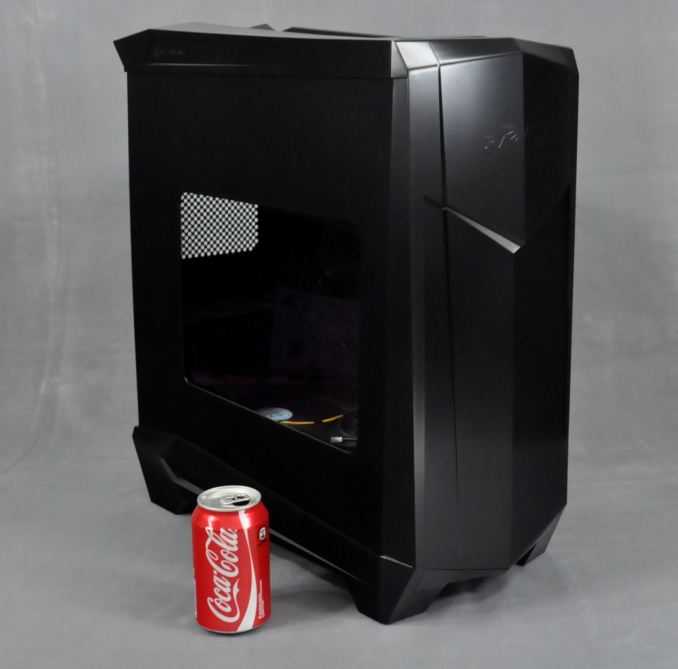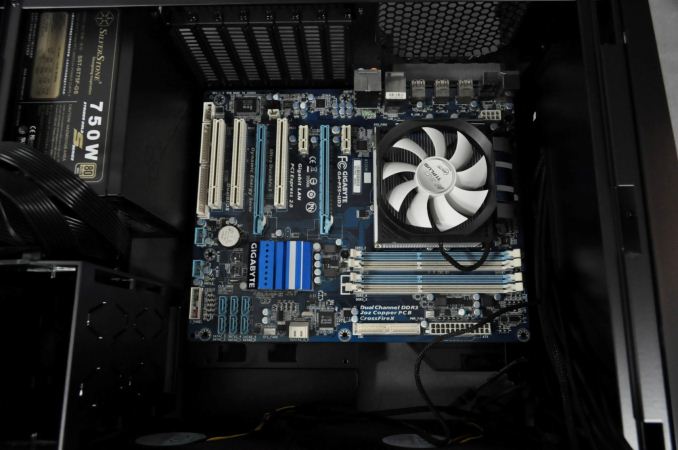SilverStone Raven RV05 Case Review
by E. Fylladitakis on December 24, 2014 10:00 AM EST- Posted in
- Cases/Cooling/PSUs
- SilverStone
- Case
Final Words
The Raven RV05 appears to be an attempt from SilverStone to develop a case not plagued by the issues that the previous models of the series had. By rotating the motherboard tray, the length of the case had to be significantly increased, leading to overly long and peculiarly shaped designs. This is not true for the Raven RV05, which does have a rotated motherboard tray and remains just as small as a typical Midi-ATX case. The cost of this design endeavor however has been tremendous, with a dramatic impact on the expandability and flexibility of the case.
SilverStone's whole point behind the rotated motherboard design is that it offers better thermal performance. We can validate their claims, as the Raven RV05 performed admirably during our testing for a case of this size. SilverStone is not joking with their claims that this design aids convective heat transfer, as the top of the Raven RV05 was literally spilling heat into the room during our testing, with the case acting exactly like a convective heater.
While the thermal performance certainly is the brightest feature of the Raven RV05, the list of the bleak points is fairly long. The 5.25" bays are entirely gone and there are no visible 3.5" bays, with the only optical drive option being a more expensive slot-loading drive. There are only two 3.5" bays, which are probably enough for most users but not for everyone, while the two 2.5" drive slots positioned behind the motherboard tray can be a bit more difficult for wire routing. Adding, removing, or upgrading system components inside the Raven RV05 is very easy, but the lack of proper space for cable management is likely to cause a mess.
The issues are not limited to the expandability of the system but affect its compatibility with current components as well. We cannot (safely) install a very large PSU, therefore we recommend against the installation of a very powerful system inside the RV05 to begin with. With the appropriate selection of components, an SLI/Crossfire system with two cards would be alright – as long as the cards are not longer than 310mm.
Finally, for the installation of a dual radiator, the user needs to remove the 180mm intake fans and rely on the fans of the radiator itself. As this is the only major air intake of the Raven RV05, the installation of a radiator will obviously increase the temperature of the air entering the system as well. The increase of the air temperature will likely be very small but, in conjunction with the notable airflow reduction from the use of smaller fans and the inclusion of the radiator's airflow resistance, it will most certainly make a noticeable difference on the thermal performance of the system. We would recommend users looking to install a radiator opt for a different case.
In terms of design, the Raven RV05 is not a subtle product. It is not as extravagant at the previous models of the series, but the aggressive appearance remains a constant. It may be a unique design, yet it will not appeal to certain groups of users, especially those seeking minimalism or elegance. Bluntly put, the Raven RV05 is not the kind of case that would match an office space or living room. As far as quality goes, SilverStone designed the Raven RV05 very well. We could not find mechanically weak spots and the case is admirably strong and sturdy considering the extensive use of plastic.
The SilverStone Raven RV05 can currently be had for $117 including shipping ($107 after rebate), or there's a windowless version for about the same price (but with no mail-in rebate). It is not a bargain but the price is fair for what this case offers. Would we recommend it? Considering the uniqueness of the case, both internally and externally, that is a complicated question.
Assuming that the user likes the external design to begin with, we would likely recommend it if it is going to host a typical gaming system that is unlikely to be upgraded often and/or soon. For users that do upgrade often or for those that simply feel that they need versatility, the Raven RV05 could cause unnecessary problems in the future. We also advice against the use of dual radiator liquid cooling setups with the Raven RV05 – the case can take them but at the expense of its large intake fans and that can easily have a negative impact on the performance of the case.
In short, the Raven RV05 is like many other SilverStone cases: an acquired taste. Some users will love it, others will find plenty of fault in design decisions. It's not the easiest case to work with, nor is it a great value, but cases are one of the few areas with modern PCs that allow the owner to make a statement. If you like the looks of the RV05 and have experience with building systems, it can make for a good enclosure.












29 Comments
View All Comments
Blaid - Wednesday, December 24, 2014 - link
Thanks for posting a review of a unique case on Christmas Eve. A nice read for those of us sitting at help desks nation wide.Tikcus9666 - Wednesday, December 24, 2014 - link
+1Flunk - Wednesday, December 24, 2014 - link
That's rough, I used to have to do that. Take heart, at some point you'll not be the entry-level help desk guy any more and you won't have to work Christmas Eve.gopher1369 - Thursday, December 25, 2014 - link
I personally can't wait until I'm 3rd line support and am on call 24/7 including Christmas Day, that will be a huge improvement!lavaheadache - Wednesday, December 24, 2014 - link
gotta love that you used a GTX 295 in the build. An oldie but a goodieromrunning - Wednesday, December 24, 2014 - link
"With the exception of the RV04, which does not share the 90° design, the cases of the Raven series were somewhat bulky and excessively long – features that did not make them very popular among users."The RVZ01 Raven is a mini-ITX case - perhaps you can review that one as it definitely isn't bulky or excessively long.
wiz329 - Wednesday, December 24, 2014 - link
Glad to see a new case review, it's been awhile!lorribot - Wednesday, December 24, 2014 - link
Bottom up cooling is a sensible way to go, however current motherboard ATX and mATX siz and shape limits things, ITX would be a better way to go but you are limited by number of graphics cards they extra cost of the MoBos themselves (why do we still pay more for less?), perhaps this is why Apple design their own MoBos and why they can do things like the the Mac Pro.SHuttle used to do thier own MoBos in their cases, I am sure they would be a market for an inovative case manufacturer or boutique PC company (or even Alienware with Dell backing) to come up with a truly unique design with a nonstandard mobo.
Or a mobo manufacturer to come up with split MoBo (say CPU/RAM and PCI-x/SATA/USB) that could be used in more inovative case designs.
It just needs someone with some vision and who can think out of the box.
JarredWalton - Wednesday, December 24, 2014 - link
Sadly, long-term reliability of Shuttle cases was highly suspect in my experience. I reviewed probably a dozen or so of their SFFs in the 2004-2006 time frame, and nearly every one ended up dead within two years. Which isn't to say other companies were better with those early proprietary SFFs -- I think every option basically was questionable. Biostar, MSI, Shuttle, Foxconn... they all often failed within a year or two (sometimes even less). That was the problem with CPUs using so much power, and we've improved a lot since then plus manufacturing tends to be better. What's crazy is that our modern ITX designs aren't really any less expensive than the old proprietary stuff. :'(Zimeon - Wednesday, December 24, 2014 - link
What the hell is that coca-cola can doing in the picture? *sigh* But nice case review none the less.